Self-Start Multi-Wavelength Laser Source with Tunable Delay-Line Interferometer and Optical Fiber Reflector for Wireless Communication System
Abstract
1. Introduction
2. Experimental Setup and Results
3. Conclusions
Author Contributions
Funding
Institutional Review Board Statement
Informed Consent Statement
Data Availability Statement
Conflicts of Interest
References
- Chen, Y.W.; Zhang, R.; Hsu, C.W.; Chang, G.K. Key Enabling Technologies for the Post-5G Era: Fully Adaptive, All-Spectra Coordinated Radio Access Network with Function Decoupling. IEEE Commun. Mag. 2020, 58, 60–66. [Google Scholar] [CrossRef]
- Shiu, R.K.; Chen, Y.W.; Peng, P.C.; Su, S.J.; Shao, G.M.; Chiu, J.; Li, J.W.; Chang, G.K. A Simplified Radio-over-Fiber System for over 100-km Long-reach n-QAM Transmission. IEEE Photonics J. 2020, 12, 7902908. [Google Scholar] [CrossRef]
- Zhou, Q.; Chen, Y.W.; Shen, S.; Kong, Y.; Xu, M.; Zhang, J.; Chang, G.K. Proactive real-time interference avoidance in a 5G millimeter-wave over fiber mobile fronthaul using SARSA reinforcement learning. Opt. Lett. 2019, 44, 4347–4350. [Google Scholar] [CrossRef] [PubMed]
- Chen, Y.W.; Peng, P.C.; Yan, J.H.; Shen, S.; Zhou, Q.; Huang, L.; Liu, S.; Zhang, R.; Feng, K.M.; Chang, G.K. Elastic Optical Transmission of 50 Gb/s/Lambda OFDM Based Mobile Fronthaul via DSP-Aided Sub-band Spreading. In Proceedings of the OSA/IEEE Optical Fiber Communication Conference (OFC2019), San Diego, CA, USA, 3–7 March 2019. Paper M2B. 2. [Google Scholar]
- Lin, C.T.; Shih, P.T.; Chen, J.; Peng, P.C.; Dai, S.P.; Jiang, W.J.; Xue, W.Q.; Chi, S. Cost-Effective Multiservices Hybrid Access Networks With no Optical Filter at Remote Nodes. IEEE Photonics Technol. Lett. 2008, 20, 812–814. [Google Scholar]
- Chang, G.K.; Chen, Y.W. Key New Fiber Wireless Access Technologies for 5G and Beyond. IEEE 5G Tech Focus 2019, 3, 2339. [Google Scholar]
- Alfadhli, Y.; Yao, S.; Omar, M.S.; Su, S.J.; Shen, S.; Zhang, R.; Chen, Y.W.; Peng, P.C.; Chang, G.K. Design of Flexible Fronthaul Featuring Per-UE Granularity and RU-level Puncturing for URLLC Applications. In Proceedings of the 2020 Optical Fiber Communications Conference and Exhibition (OFC), San Diego, CA, USA, 8–12 March 2020. [Google Scholar]
- Chang, G.K.; Peng, P.C. Grand Challenges of Fiber Wireless Convergence for 5G Mobile Data Communications. In Proceedings of the 2018 23rd Opto-Electronics and Communications Conference (OECC), Jeju, Korea, 2–6 July 2018. [Google Scholar]
- Alfadhli, Y.; Xu, M.; Liu, S.; Lu, F.; Peng, P.C.; Chang, G.K. Real-Time Demonstration of Adaptive Functional Split in 5G Flexible Mobile Fronthaul Networks. In Proceedings of the Optical Fiber Communication Conference 2018, San Diego, CA, USA, 11–15 March 2018. [Google Scholar]
- Huang, M.Y.; Chen, Y.W.; Shiu, R.K.; Wang, H.; Chang, G.K. A Bi-Directional Multi-Band, Multi-Beam mm-Wave Beamformer for 5G Fiber Wireless Access Networks. J. Light. Technol. 2021, 39, 1116–1124. [Google Scholar] [CrossRef]
- Alfadhli, Y.; Peng, P.C.; Shen, S.; Yao, S.; Omar, M.S.; Chen, Y.W.; Mitani, S.M.; Chang, G.K. Towards Dynamic 5G Networks Utilizing Flexible Function Split. In Proceedings of the 2019 IEEE MTT-S International Microwave Conference on Hardware and Systems for 5G and Beyond (IMC-5G), Atlanta, GA, USA, 15–16 August 2019. [Google Scholar]
- Vallejo, L.; Ortega, B.; Almenar, V.; Bohata, J.; Zvanovec, S.; Nguyen, D.N. SOA-aided photonic signal generation for hybrid fibre and FSO 5G transmission links. Nonlinear Opt. Its Appl. 2020, 11358, 113581R. [Google Scholar]
- Bohata, J.; Nguyen, D.N.; Spacil, J.; Komanec, M.; Ortega, B.; Vallejo, L.; Ghassemlooy, Z.; Zvanovec, S. Experimental comparison of DSB and CS-DSB mmW formats over a hybrid fiber and FSO fronthaul network for 5G. Opt. Express 2021, 29, 27768–27782. [Google Scholar] [CrossRef] [PubMed]
- Yao, S.; Chen, Y.W.; Su, S.J.; Alfadhli, Y.; Shen, S.; Zhang, R.; Zhou, Q.; Chang, G.K. Non-Orthogonal Uplink Services Through Co-Transport of D-RoF/A-RoF in Mobile Fronthaul. J. Light. Technol. 2020, 38, 3637–3643. [Google Scholar] [CrossRef]
- Shiu, R.K.; Chen, Y.W.; Peng, P.C.; Wen, M.H.; Su, S.J.; Hsu, C.W.; Chang, G.K. Optical Signal Processing for W-Band Radio-Over-Fiber System with Tunable Frequency Response. IEEE J. Sel. Top. Quantum Electron. 2021, 27, 7600408. [Google Scholar] [CrossRef]
- Chen, Y.W.; Chang, G.K. New radio access technologies for 5G with enhanced network reliability and channel capacity. In Proceedings of the Broadband Access Communication Technologies XIV 11307, SPIE OPTO 2020, San Francisco, CA, USA, 31 January 2020. [Google Scholar]
- Peng, P.C.; Shiu, R.K.; Bitew, M.A.; Chang, T.L.; Lai, C.H.; Junior, J.I. A 12 GHz wavelength spacing multi-wavelength laser source for wireless communication systems. Opt. Laser Technol. 2017, 93, 172–179. [Google Scholar] [CrossRef]
- Lin, C.C.; Chi, Y.C.; Kuo, H.C.; Peng, P.C.; Chang-Hasnain, C.J.; Lin, G.R. Beyond-Bandwidth Electrical Pulse Modulation of a TO-Can Packaged VCSEL for 10 Gbit/s Injection-Locked NRZ-to-RZ Transmission. J. Light. Technol. 2011, 29, 830–841. [Google Scholar] [CrossRef]
- Peng, P.C.; Feng, K.M.; Peng, W.R.; Chiou, H.Y.; Chang, C.C.; Chi, S. Long-distance fiber grating sensor system using a fiber ring laser with EDWA and SOA. Opt. Commun. 2005, 252, 127–131. [Google Scholar] [CrossRef]
- Peng, P.C.; Lee, W.Y.; Wu, S.S.; Hu, H.L. Multiwavelength fiber laser for the fiber link monitoring system. Opt. Laser Technol. 2013, 51, 62–66. [Google Scholar] [CrossRef]
- Yang, Z.Q.; Huang, T.J.; Chang, Y.J.; Yeh, C.H.; Chow, C.W.; Chen, J.H.; Chen, K.H. Switchable dual-wavelength single-longitudinal-mode erbium fiber laser utilizing a dual-ring scheme with a saturable absorber. Laser Phys. 2018, 28, 065104. [Google Scholar] [CrossRef]
- Yeh, C.H.; Chow, C.W.; Lu, S.S. Use of a reflective semiconductor optical amplifier and dual-ring architecture design to produce a stable multi-wavelength fiber laser. Laser Phys. 2014, 24, 055101. [Google Scholar] [CrossRef][Green Version]
- Chi, Y.C.; Peng, P.C.; Lin, G.-R. Clock-free RZ-BPSK data generation using a self-starting optoelectronic oscillator. J. Light. Technol. 2011, 29, 1702–1707. [Google Scholar] [CrossRef]
- Maleki, L. The Optoelectronics Oscillator. Nat. Photonics 2011, 5, 728–730. [Google Scholar] [CrossRef]
- Chi, Y.C.; Lin, G.R. A Q -Factor Enhanced Optoelectronic Oscillator for 40-Gbit/s Pulsed RZ-OOK Transmission. IEEE Trans. Microw. Theory Tech. 2014, 62, 3216–3223. [Google Scholar] [CrossRef]

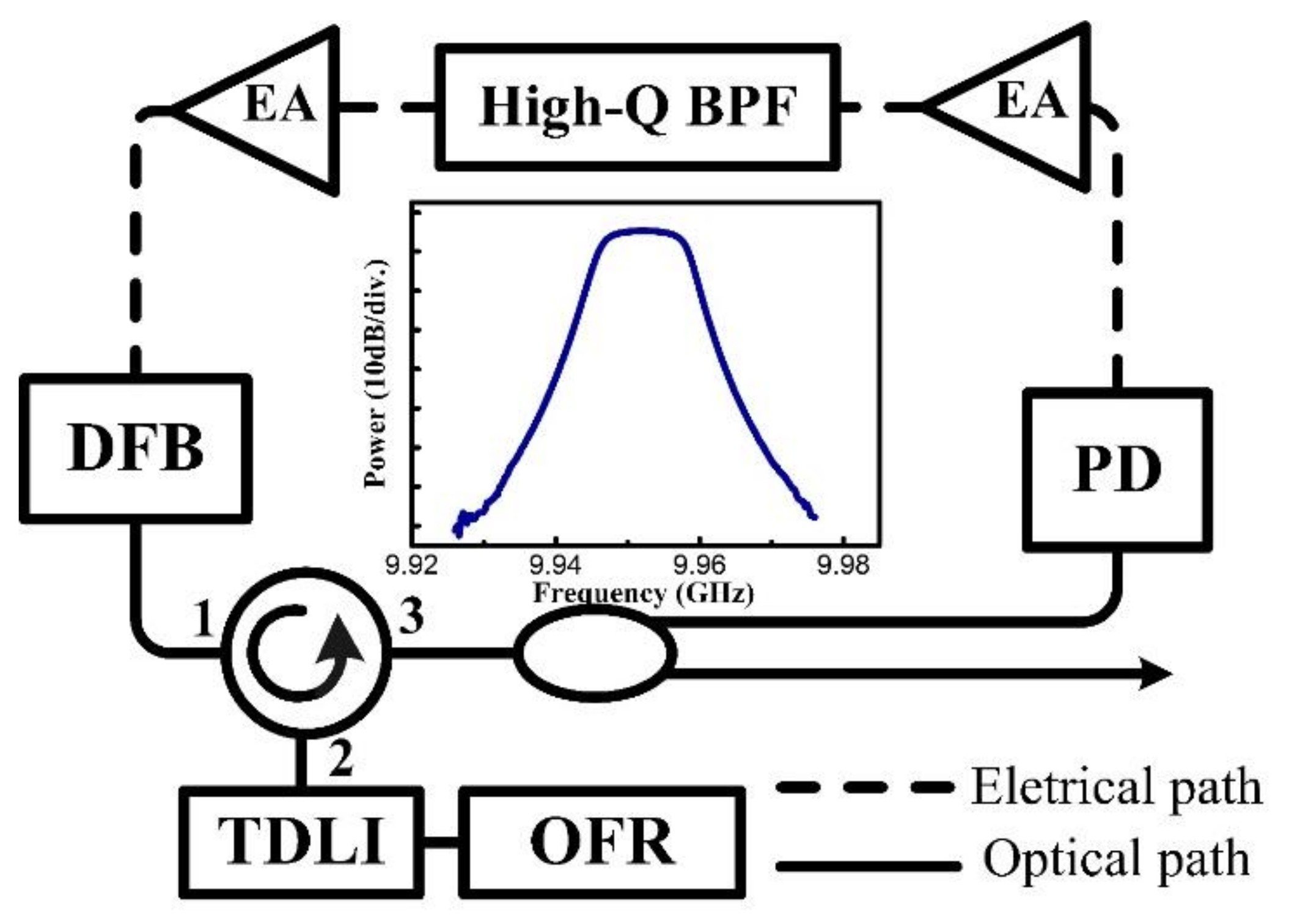
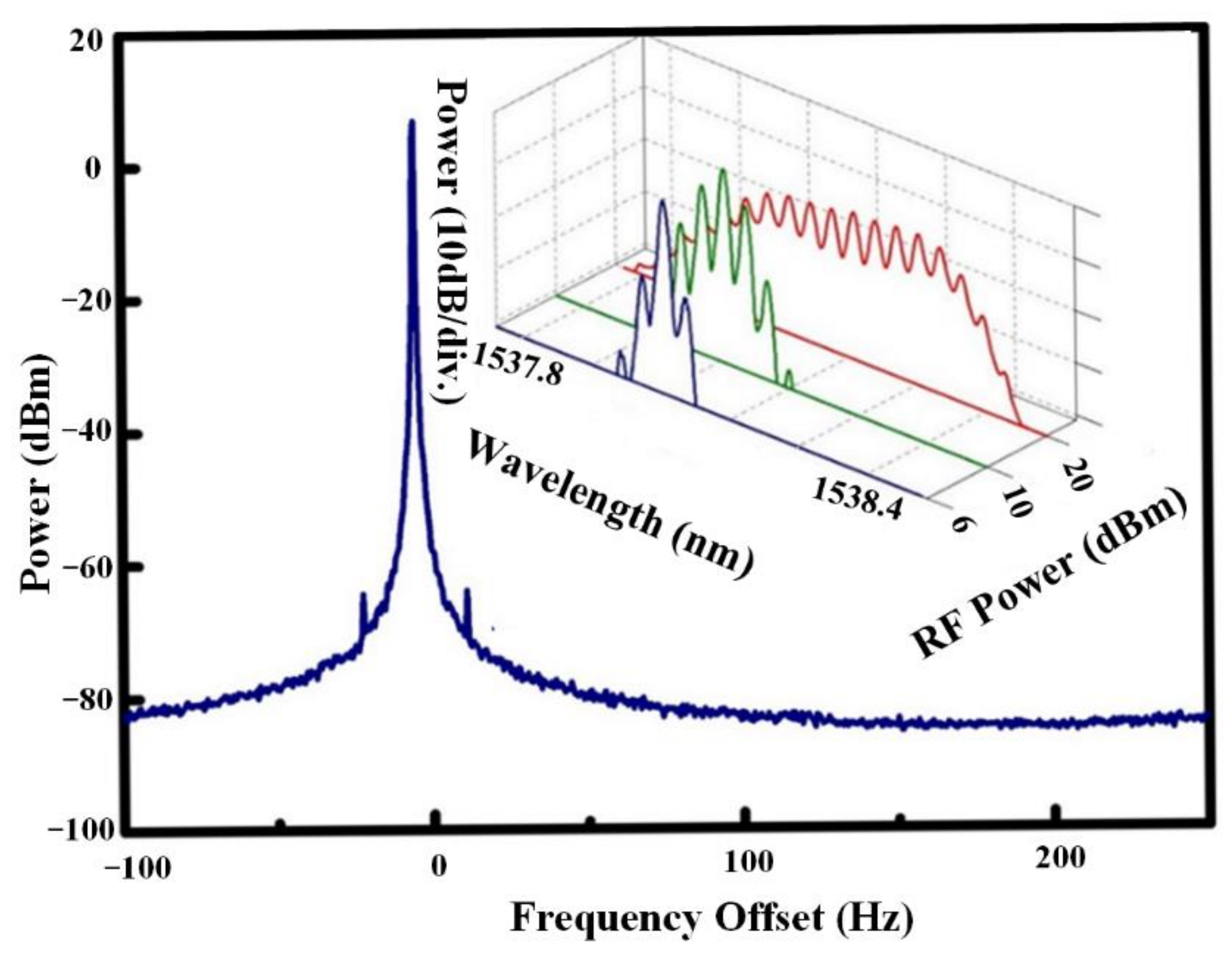
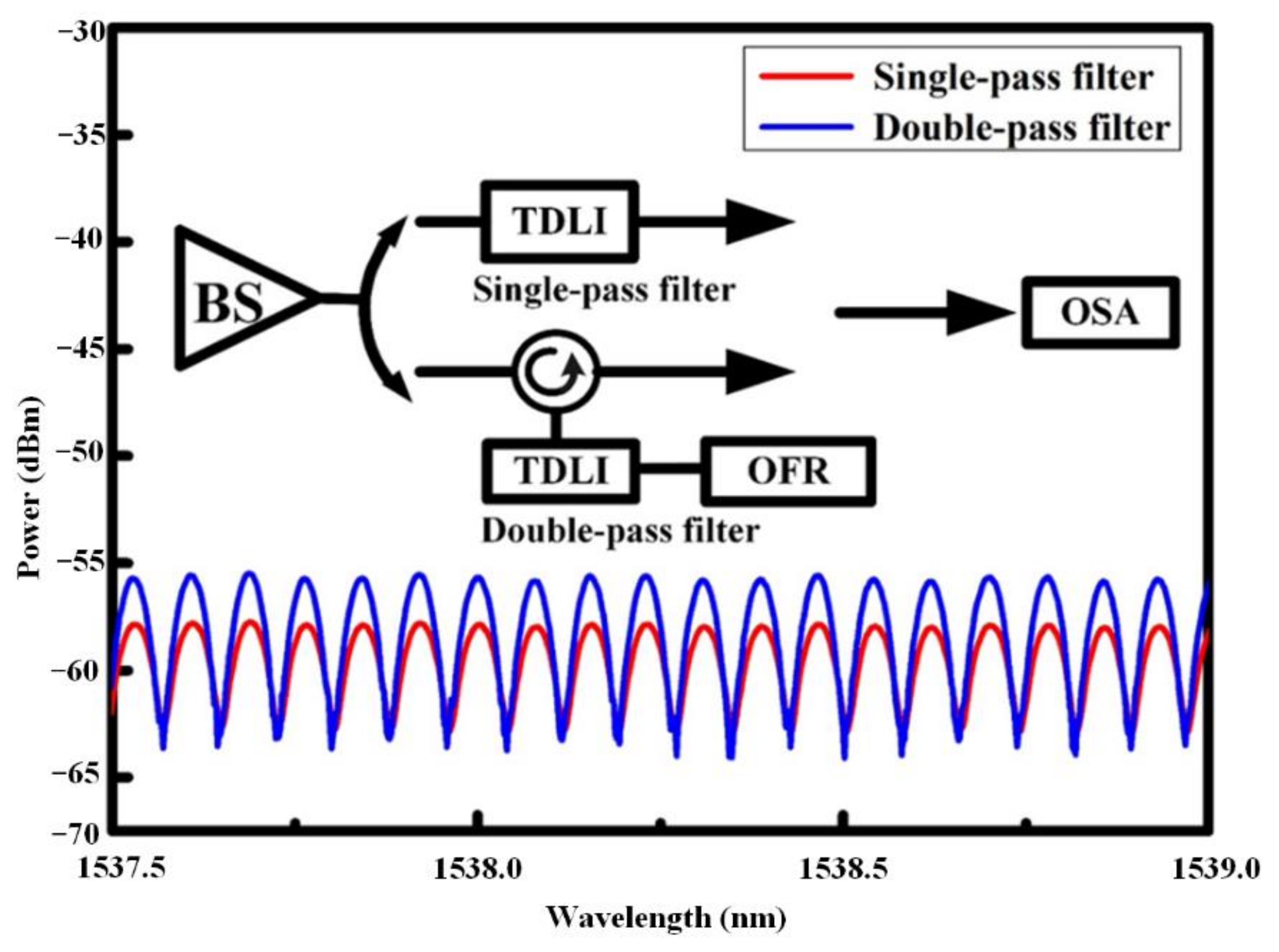
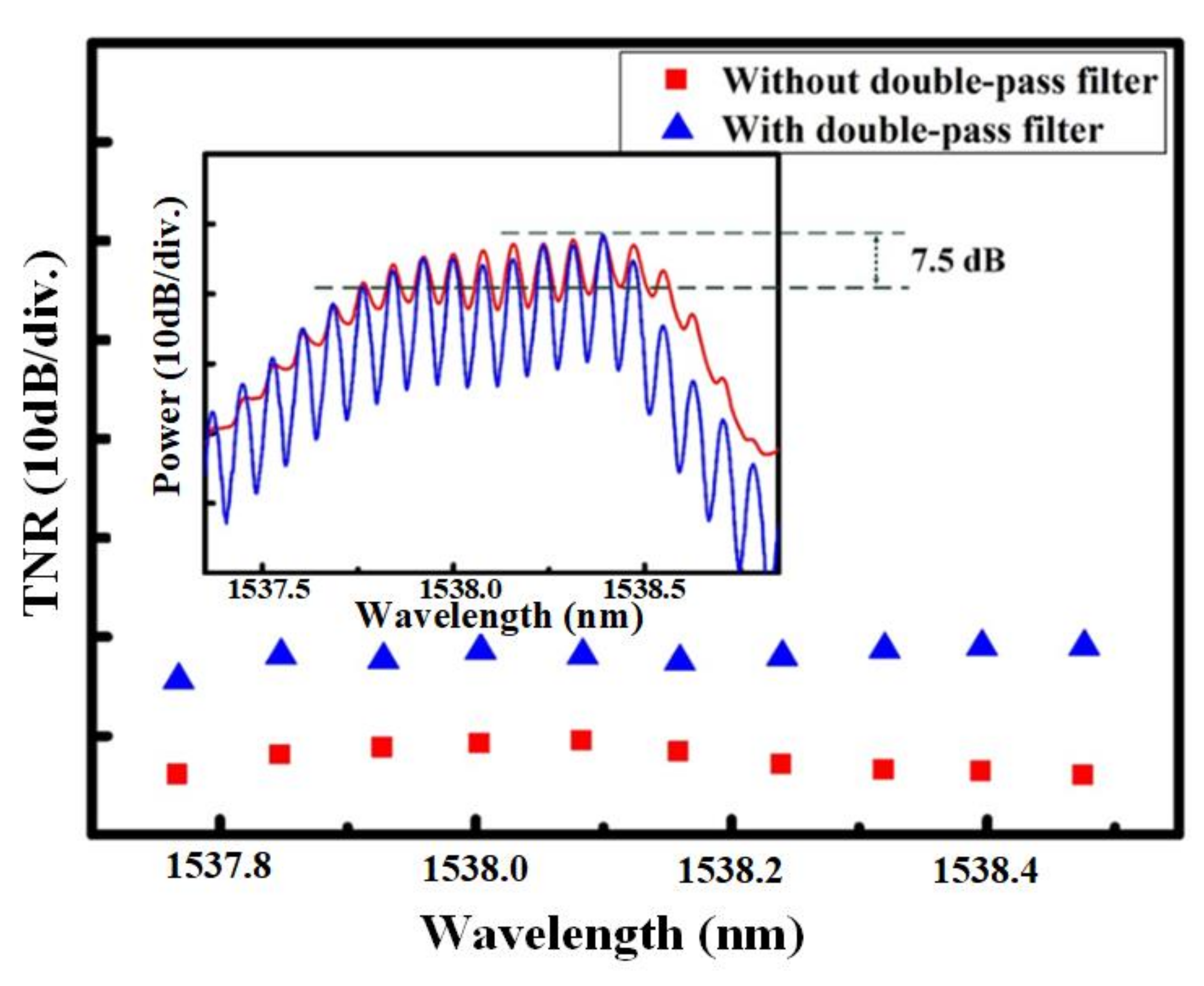
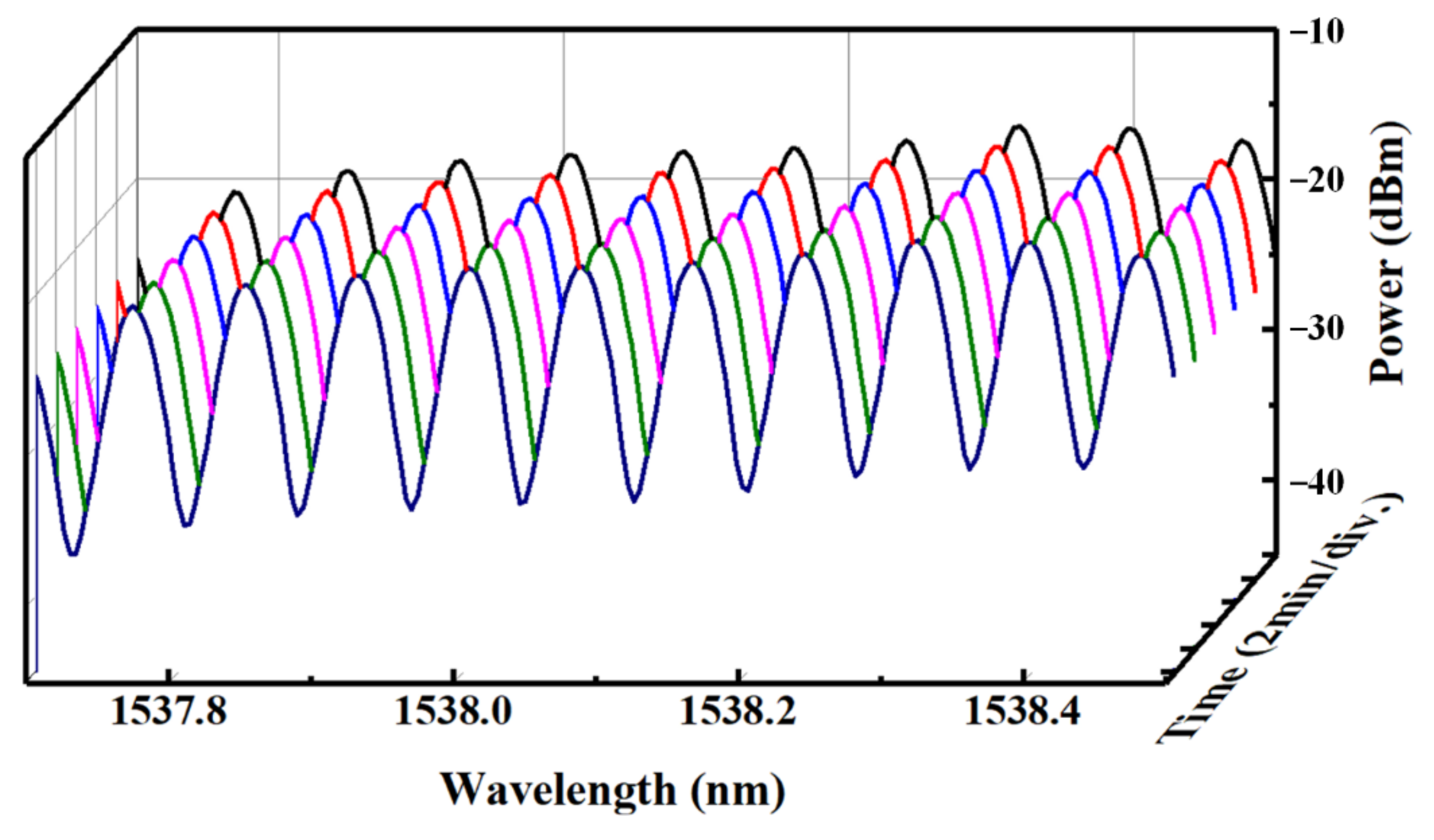
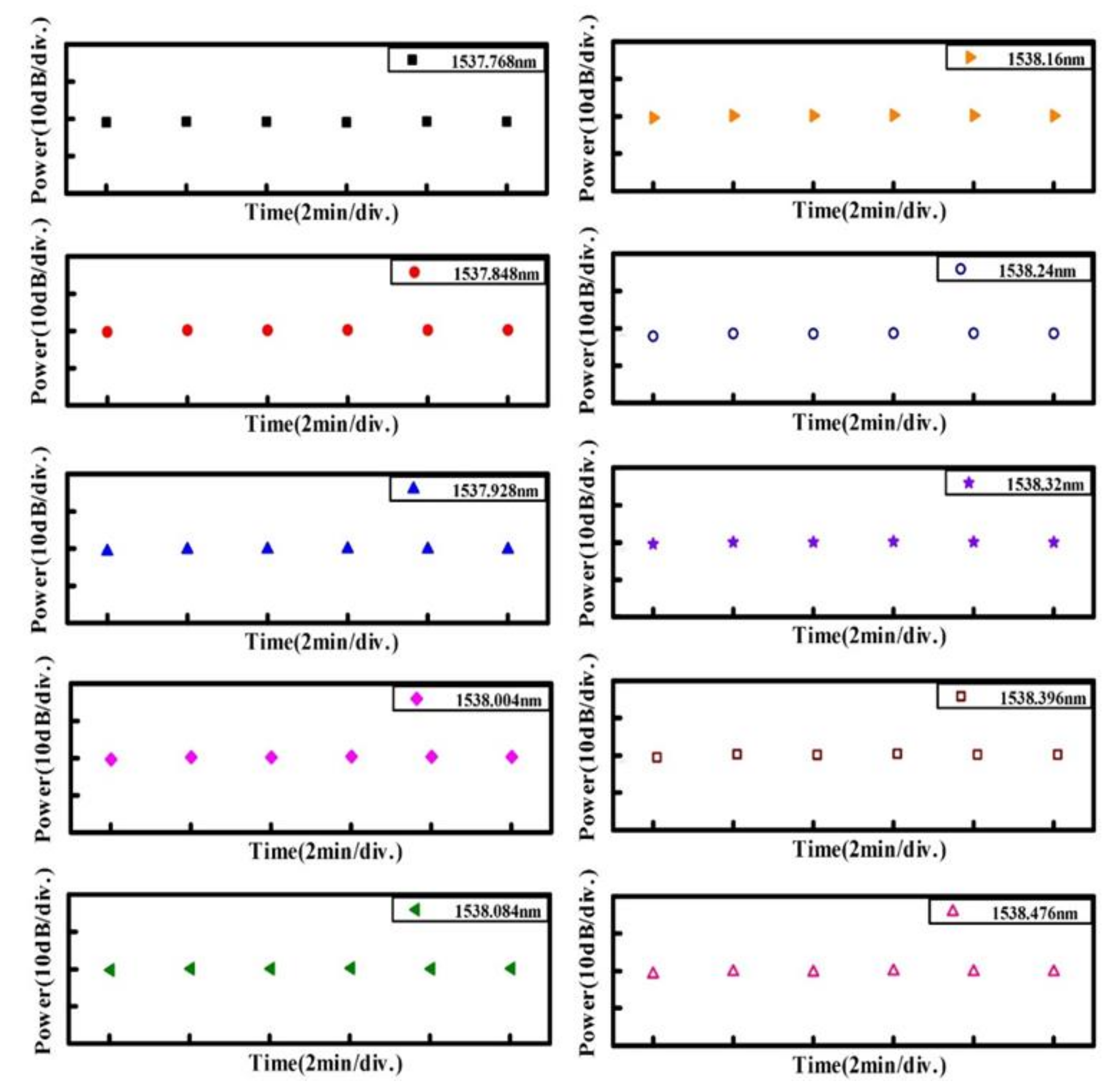

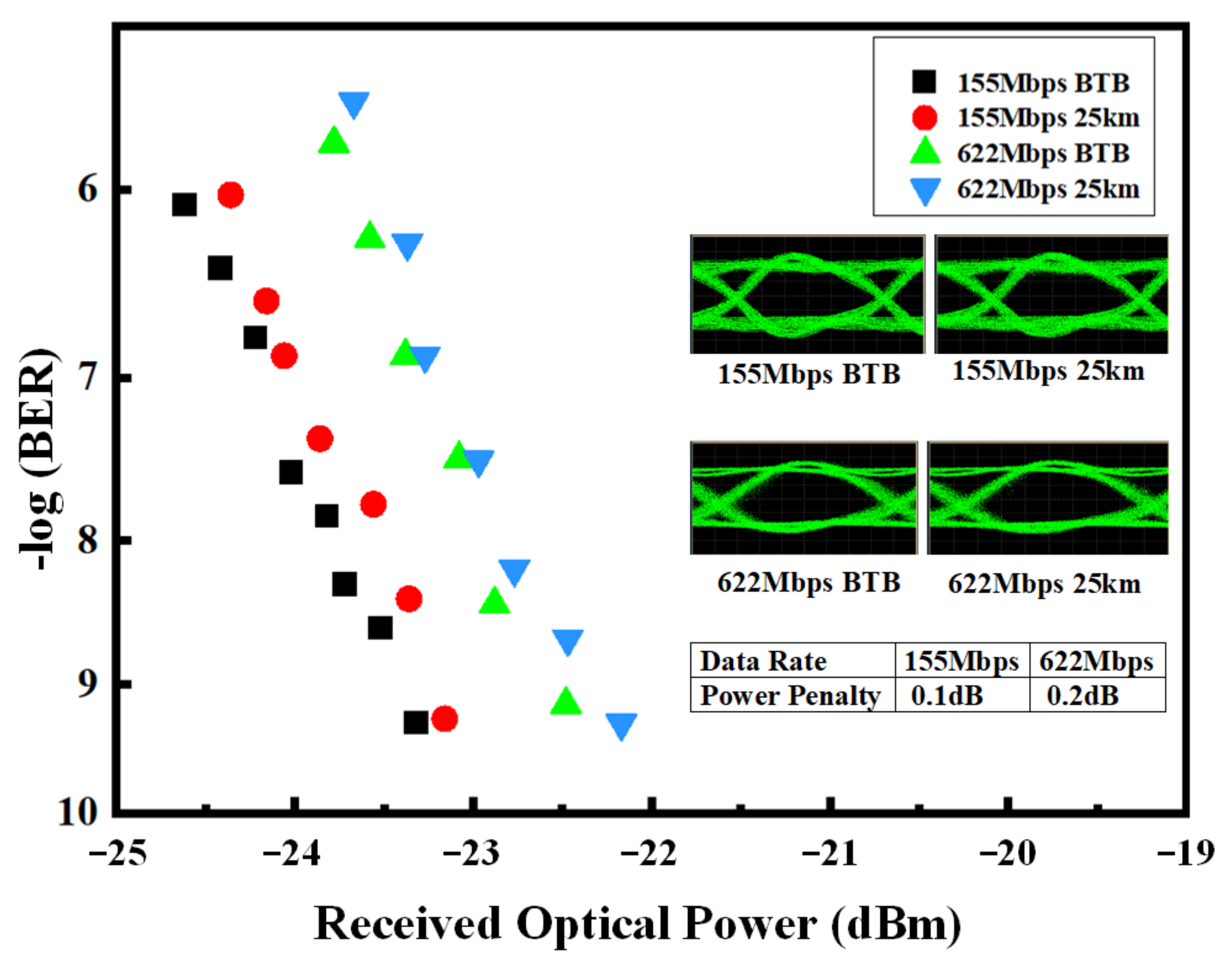
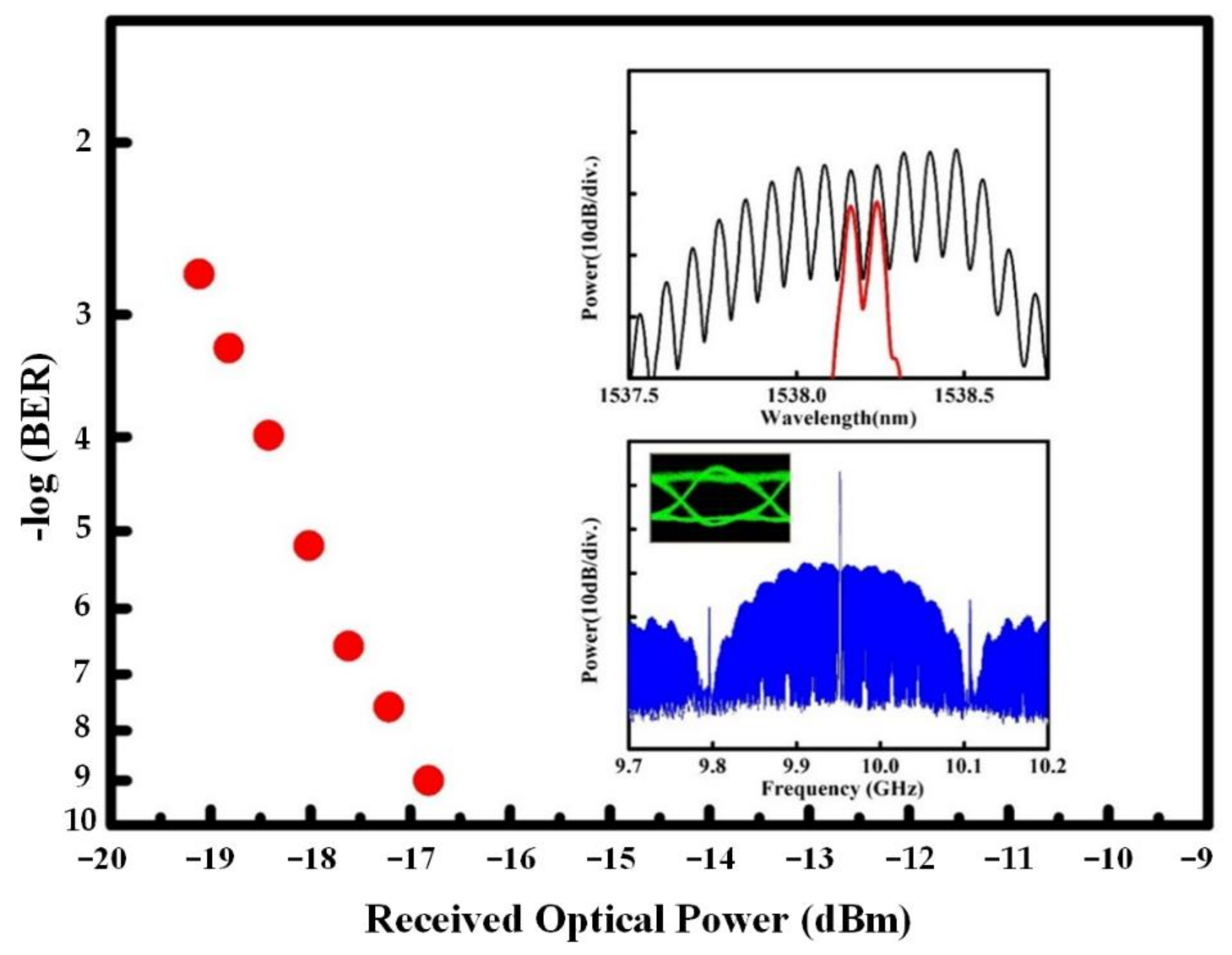
Publisher’s Note: MDPI stays neutral with regard to jurisdictional claims in published maps and institutional affiliations. |
© 2021 by the authors. Licensee MDPI, Basel, Switzerland. This article is an open access article distributed under the terms and conditions of the Creative Commons Attribution (CC BY) license (https://creativecommons.org/licenses/by/4.0/).
Share and Cite
Dehnaw, A.-M.; Shiu, R.-K.; Chen, R.-B.; Li, J.-W.; Manie, Y.-C.; Liang, H.-C.; Peng, P.-C. Self-Start Multi-Wavelength Laser Source with Tunable Delay-Line Interferometer and Optical Fiber Reflector for Wireless Communication System. Appl. Sci. 2021, 11, 9553. https://doi.org/10.3390/app11209553
Dehnaw A-M, Shiu R-K, Chen R-B, Li J-W, Manie Y-C, Liang H-C, Peng P-C. Self-Start Multi-Wavelength Laser Source with Tunable Delay-Line Interferometer and Optical Fiber Reflector for Wireless Communication System. Applied Sciences. 2021; 11(20):9553. https://doi.org/10.3390/app11209553
Chicago/Turabian StyleDehnaw, Amare-Mulatie, Run-Kai Shiu, Ruei-Bin Chen, Jyun-Wei Li, Yibeltal-Chanie Manie, Hsing-Chih Liang, and Peng-Chun Peng. 2021. "Self-Start Multi-Wavelength Laser Source with Tunable Delay-Line Interferometer and Optical Fiber Reflector for Wireless Communication System" Applied Sciences 11, no. 20: 9553. https://doi.org/10.3390/app11209553
APA StyleDehnaw, A.-M., Shiu, R.-K., Chen, R.-B., Li, J.-W., Manie, Y.-C., Liang, H.-C., & Peng, P.-C. (2021). Self-Start Multi-Wavelength Laser Source with Tunable Delay-Line Interferometer and Optical Fiber Reflector for Wireless Communication System. Applied Sciences, 11(20), 9553. https://doi.org/10.3390/app11209553






